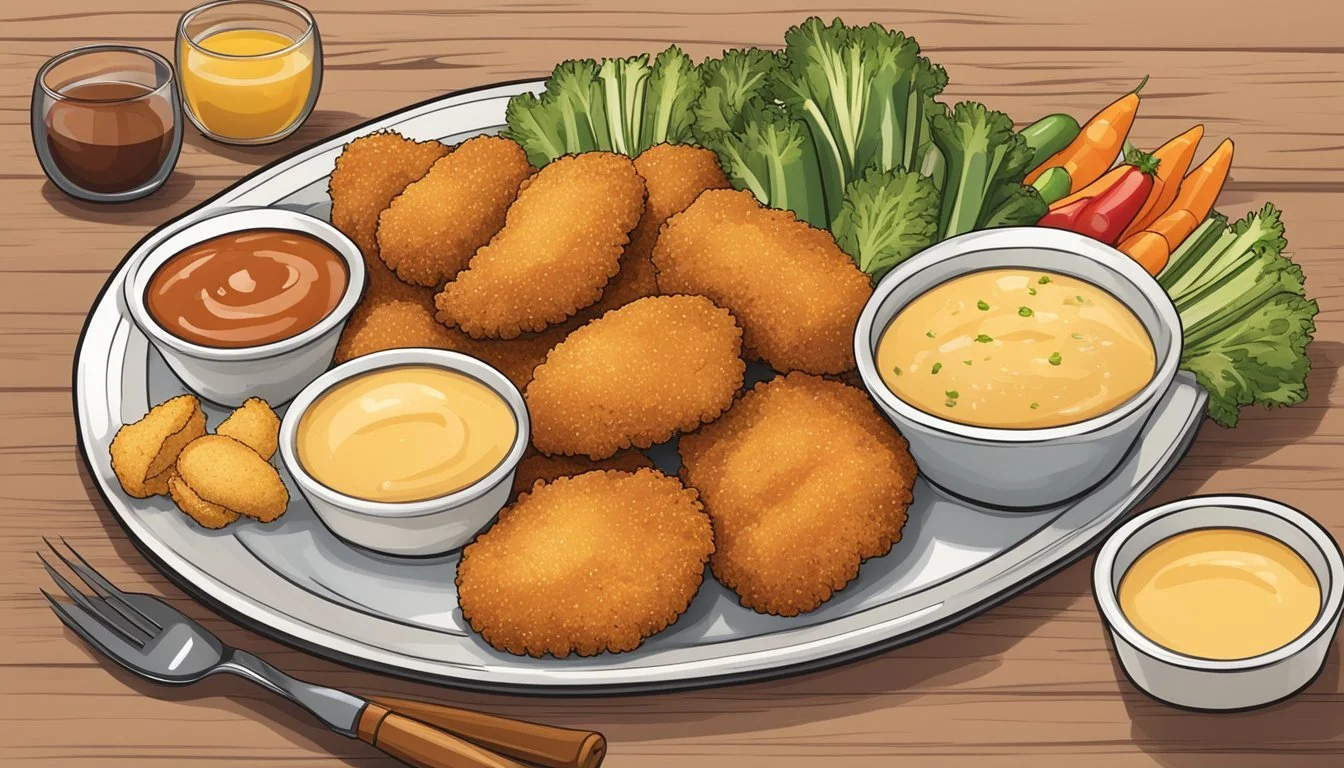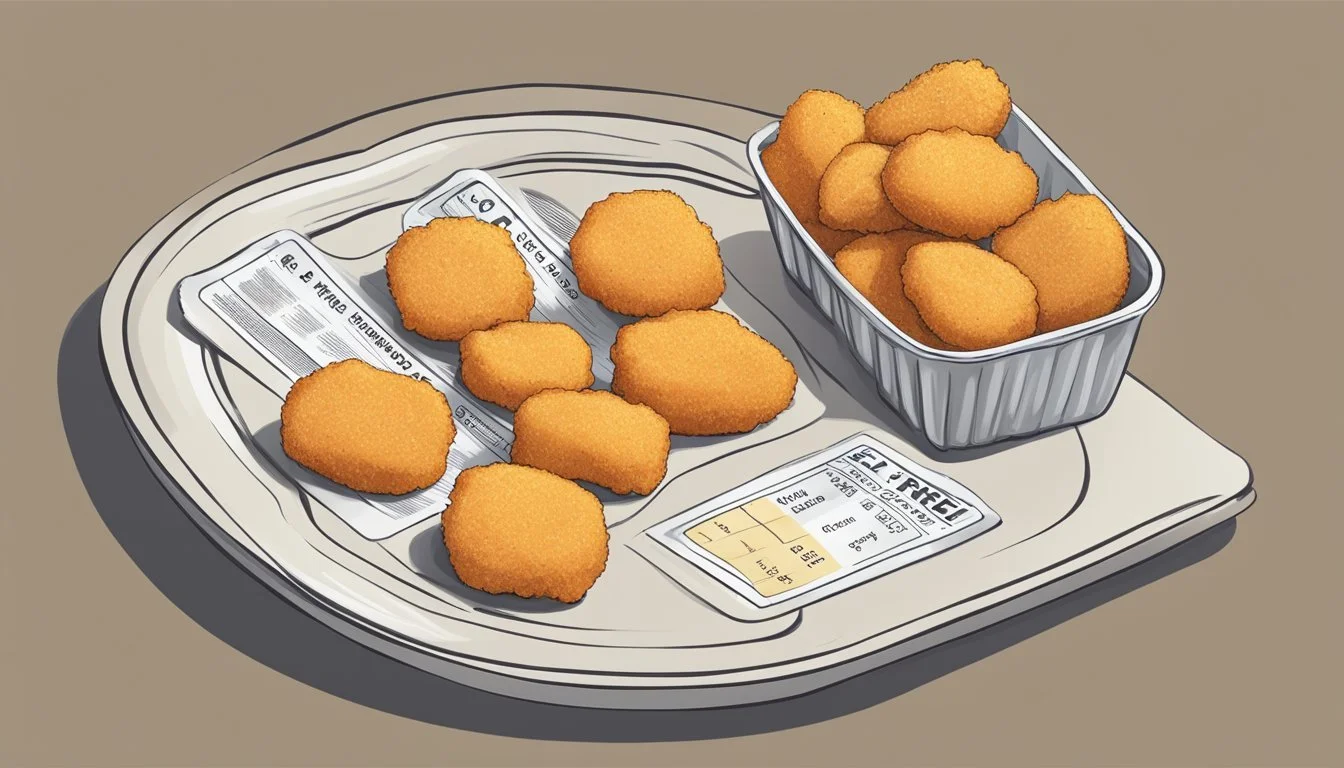Are Chicken Nuggets Gluten-Free?
Unveiling the Truth for Celiac Awareness
Chicken nuggets, a popular and convenient meal choice for both children and adults alike, are traditionally made with breaded chicken, which typically contains gluten. Gluten is a group of proteins found in wheat, barley, and rye, making standard chicken nuggets unsuitable for those with celiac disease or gluten sensitivities. However, an increasing awareness and demand for gluten-free options have led to the availability of gluten-free chicken nuggets in both stores and recipes for homemade versions.
The key to gluten-free chicken nuggets is in the breading. Gluten-free alternatives often utilize coatings made from corn or rice flours, gluten-free bread crumbs, or even ground-up corn tortilla chips to achieve the classic nugget texture without the use of gluten. Baking and frying are both viable cooking methods; whether baked in an oven or fried in a pan or air fryer, these alternatives aim to provide a similar taste and crunch to conventional chicken nuggets.
Restaurants and frozen food brands are also recognizing the need for gluten-free options, offering specially prepared gluten-free chicken nuggets to cater to this dietary requirement. It is imperative for consumers to look for labels certifying the product as gluten-free to ensure the avoidance of cross-contamination with gluten during the production process. This development in the food industry reflects a growing commitment to inclusivity and the health needs of consumers who are seeking gluten-free food choices for various reasons.
What Are Gluten-Free Chicken Nuggets?
Gluten-free chicken nuggets are a popular alternative to traditional chicken nuggets, catering to those with celiac disease, gluten sensitivities, or anyone adhering to a gluten-free diet. The primary difference between them and standard nuggets lies in the use of gluten-free coatings and binders.
Ingredients:
Chicken: The central ingredient remains the same—typically chicken breast cut into bite-sized pieces.
Gluten-Free Flour: A substitute for wheat flour, common choices include rice flour, almond flour, or coconut flour.
Breadcrumbs: Essential for the crispy exterior, these are often made from gluten-free bread or cereals that do not contain wheat, barley, or rye.
Breading: The outer coating can include a variety of gluten-free options such as cornmeal or crushed corn tortilla chips.
Preparation: Chicken pieces are usually dipped in a gluten-free flour mix, followed by a liquid binder such as egg or a dairy-free alternative, and finally coated with gluten-free breadcrumbs. The nuggets can be cooked by various methods like baking, frying, or air frying, depending on personal preference and dietary needs.
Table: Common Cooking Methods
Method Temperature Duration Baking 350°F 20-30 minutes Air Frying 350°F 7-10 minutes Deep Frying 350°F 7-8 minutes
Gluten-free chicken nuggets offer a texture and taste similar to their gluten-containing counterparts, with the added benefit of being safe for those avoiding gluten. Brands often experiment with seasonings to achieve a range of flavors, from the classic savory profile to more exotic blends. It is important for consumers to check product labels for certification and to avoid cross-contamination if they have serious allergies or celiac disease.
Ingredients and Substitutions
Creating gluten-free chicken nuggets requires careful selection of ingredients to avoid gluten and cater to possible allergies. The components must balance taste, texture, and dietary needs without compromising safety and enjoyment.
Essential Ingredients for Gluten-Free Nuggets
For gluten-free chicken nuggets, one must use gluten-free flour as a base for the coating. Simple ingredients such as chicken breast ensure a high-quality protein source. An egg is often utilized for binding the flour to the chicken. Observe the following essential ingredients:
Chicken breast: The primary source of protein and base for the nuggets.
Gluten-free flour: Options include rice, chickpea, or gluten-free all-purpose flour.
Egg: Acts as a binder to help the coating adhere to the chicken.
Common Substitutes for Allergy-Friendly Options
Individuals with additional dietary restrictions beyond gluten may require substitutions. Here’s a rundown of allergy-friendly options:
Allergy Substitute Dairy Use dairy-free alternatives for any milk or cheese. Egg Use a commercial egg replacement or a flaxseed meal. Nuts Ensure flour blends or seasonings are nut-free.
Dairy-free: For recipes calling for milk or cheese, alternatives like almond milk or nutritional yeast can be used.
Egg-free: Substitute eggs with flaxseed mix or commercial binders to maintain the texture.
Nut-free: Choose gluten-free flours and ingredients that don’t contain or cross-contaminate with nuts.
Gluten-Free Breading and Seasoning
Creating gluten-free chicken nuggets requires careful selection of breading materials and a harmonious blend of spices to ensure the nuggets are both tasty and compliant with a gluten-free diet.
Choosing the Right Breading
For the breading, the choice of gluten-free flour is paramount. Options include:
Rice flour: Offers a light and crispy texture.
Gluten-free all-purpose flour: Can mimic the properties of traditional wheat flour.
Almond flour: Adds a nutty flavor and is also low-carb.
Another component to consider is the use of gluten-free breadcrumbs or panko. These can be purchased pre-made or prepared by pulsing gluten-free bread in a food processor until fine crumbs form. For added crunch, some recipes may incorporate a mixture of these breadcrumbs and flour.
Seasoning Mix for Flavor Enhancement
A well-balanced seasoning mix can significantly elevate the flavor of gluten-free chicken nuggets. A basic seasoning blend might include:
Salt (to taste)
Black pepper (to taste)
Garlic powder: 1 teaspoon
Onion powder: 1 teaspoon
Paprika: Adds depth and a hint of smokiness. Use 1/2 teaspoon.
Additional spices such as Italian seasoning, chili powder, or cayenne pepper can be added depending on one's taste preference.
Each ingredient in the seasoning mix should be checked to ensure it's gluten-free, as some spice blends might contain additives with gluten.
Preparation Techniques
When preparing gluten-free chicken nuggets, one has three main techniques to choose from: baking in the oven, using an air fryer, or traditional frying. Each method offers a different texture and flavor profile to the chicken nuggets.
Baking Chicken Nuggets in the Oven
For oven baking, preheat the oven to 350°F and line a baking sheet with parchment paper to prevent sticking. The chef coats the chicken pieces in the gluten-free flour mixture, followed by dipped egg mixture using a whisk for uniformity, and finishes with a layer of gluten-free breadcrumbs. Nuggets should be arranged on the baking sheet in a single layer, ensuring they are not touching, and baked until golden brown and cooked through, which usually takes about 15-20 minutes.
Using an Air Fryer for Crispiness
An air fryer provides a crispy texture similar to deep-frying but with less oil. To cook chicken nuggets in an air fryer, one must first preheat the device as per the manufacturer's instructions, usually around 350°F. After preparing the nuggets with a gluten-free coating, they are placed in the air fryer basket in a single layer. Tongs are useful for turning the nuggets to ensure even cooking, which generally takes about 7-10 minutes.
Frying Nuggets for Traditional Texture
Frying in oil is the traditional way to achieve a savory texture and rich flavor. It involves heating oil in a deep-fryer or heavy pan to 350°F. Chickens are then fried in batches to prevent overcrowding, using tongs to turn for even browning. Nuggets are typically cooked for 7-8 minutes until they reach a satisfying golden brown. It's essential to drain the excess oil on a rack or paper-lined plate to keep them from becoming soggy.
Cooking Equipment and Utensils
When preparing gluten-free chicken nuggets, selecting the appropriate cooking equipment and utensils is crucial to avoid cross-contamination with gluten. Safe preparation methods include baking and air frying, both of which necessitate specific utensils and appliances.
For baking, one will need a preheated oven and a baking sheet lined with parchment paper. The parchment paper ensures that the nuggets do not stick and that there is no residual gluten from previous baking activities. Tongs may be utilized to flip the chicken nuggets halfway through baking to ensure an even cook on both sides.
On the other hand, air frying requires an air fryer. It circulates hot air around the nuggets, yielding a crispy exterior without the need for deep frying. As air fryers generally have non-stick baskets, additional lining is unnecessary. However, it is recommended to shake the basket or use tongs to turn the nuggets for uniform crispiness.
In terms of utensils, a whisk is essential for thoroughly beating eggs if an egg wash is part of the breading process. When combining dry ingredients or creating a gluten-free flour mixture, using a food processor can yield a fine and well-mixed coating for the nuggets.
Equipment Usage Oven For baking nuggets at a consistent temperature. Air Fryer For a fried texture with less oil. Baking Sheet To hold nuggets during baking. Tongs For flipping nuggets without contamination. Whisk To beat eggs for coating. Food Processor For blending dry ingredients.
It is imperative that all cooking utensils are strictly used for gluten-free cooking to prevent contamination. With this targeted approach, individuals can safely enjoy gluten-free chicken nuggets with peace of mind.
Step-By-Step Cooking Instructions
Before one starts, they should ensure the availability of all ingredients necessary for a gluten-free chicken nugget recipe. The basic ingredients typically include gluten-free flour, eggs, gluten-free breadcrumbs or panko, and seasonings.
One begins by preheating their oven or air fryer to the required temperature. For an oven, one should aim for around 400º F, whereas for an air fryer, the temperature would be similar or according to the specific recipe guidance.
The baking sheet should be lined with parchment paper or lightly greased to prevent sticking. Those using an oven may use a rack over their baking sheet to help circulate air and achieve a crispy exterior.
The preparation of chicken nuggets involves creating an assembly line with three dishes: flour with seasonings, beaten eggs, and gluten-free breadcrumbs. Each chicken piece is coated in the flour mixture, dipped in egg, and then rolled in breadcrumbs.
Ingredients: Gluten-free flour, seasonings, eggs, gluten-free breadcrumbs.
Preheat: Oven or air fryer to 400º F.
Baking Sheet: Prepare with parchment or a light greasing.
Step Action 1 Coat chicken in flour and seasoning mix. 2 Dip in beaten eggs. 3 Roll in gluten-free breadcrumbs.
Once coated, the chicken nuggets are placed on the baking sheet, ensuring they do not touch so they cook evenly. In an oven, nuggets typically require 20-25 minutes, flipped halfway through. In an air fryer, cooking time is reduced, usually about 10 minutes.
One should always check that the nuggets have reached the safe internal temperature of 165º F. After achieving this temperature, the nuggets are ready to serve, using the recipe card for guidance on serving sizes and accompaniments.
Nutritional Information
This section provides a detailed look at the nutritional content of gluten-free chicken nuggets, focusing on their caloric, macronutrient, sodium, and allergen profiles.
Calories and Macronutrient Breakdown
Gluten-free chicken nuggets typically provide a caloric content ranging from 130 to 210 calories per serving. A standard serving size varies between brands, but generally, it is about 3-4 nuggets. Below is an example of the macronutrient breakdown per serving, based on the search results and typical nutritional values:
Calories: 130-210
Protein: Varied, catered to provide a source of lean protein.
Total Fat: Approximately 12g
Saturated Fat: Around 2.5g
Carbohydrates: Varied due to different breading formulations.
Fiber: Often minimal, as gluten-free breading may not contain substantial fiber.
Sugars: Typically low to zero, since chicken nuggets are not sweetened.
Sodium and Allergen Information
Gluten-free chicken nuggets are positioned as a suitable option for those with gluten sensitivities or allergies. Insight into their sodium content and potential allergy-inducing ingredients is pivotal for consumers managing dietary restrictions.
Sodium: Sodium levels can be significant, with some brands containing upwards of 400 mg per serving.
Allergens: Gluten-free specifically, but cross-contamination or inclusion of other allergens like soy or dairy may be present depending on the brand and manufacturing processes.
Consumers must review the product labels for the most accurate and brand-specific nutritional information.
Serving Suggestions and Pairings
Gluten-free chicken nuggets offer a versatile dining experience that can be heightened by the inclusion of the right sauces and sides. They are suitable as appetizers or entrees and can be paired with various accompaniments to suit different taste preferences.
Dipping Sauces
Gluten-free chicken nuggets pair wonderfully with a variety of dipping sauces. These sauces not only add flavor but also enhance the textural experience of the meal. Some popular choices include:
BBQ sauce: A sweet and tangy option, perfect for those who prefer a smoky touch.
Ranch dressing: Creamy and herby, ranch is a classic choice that balances the flavors of the chicken.
Honey mustard: It offers a sweet and slightly spicy kick that complements the savory taste of the nuggets.
Ketchup: A familiar and kid-friendly choice, ideal for its simple sweetness and acidity.
Sides and Companions
The right side dishes can transform gluten-free chicken nuggets from a snack into a balanced meal. Here are some tried and true companions:
Mashed potatoes: Soft and buttery, they provide a comforting contrast to the crispy texture of the chicken.
Vegetables: A healthy addition to any meal, steamed or roasted vegetables like carrots or broccoli can add color and nutrition.
Salads: A light green salad is a refreshing side that can cleanse the palate between bites.
Pairing gluten-free chicken nuggets with these sauces and sides turns a simple meal into a satisfying feast.
Storage and Reheating Tips
Proper storage and reheating are crucial for maintaining the taste and safety of leftover chicken nuggets. Chicken nuggets can be stored in the fridge or freezer and can be reheated using an oven or air fryer for best results.
How to Store Leftovers
Leftover chicken nuggets should be refrigerated or frozen promptly, ideally within two hours of cooking, to prevent bacterial growth. For refrigeration:
Fridge: Place the nuggets in an airtight container. They will remain safe for consumption and retain quality for 1-2 days.
Freezer: For longer storage, wrap the nuggets tightly in plastic wrap or aluminum foil, then place in a freezer bag. Properly stored, they can last for up to 3 months.
Best Methods to Reheat Chicken Nuggets
Reheating should bring the nuggets back to a palatable temperature without drying them out or making them soggy.
Oven Baking:
Preheat the oven to 350°F.
Spread nuggets in a single layer on a baking sheet.
Reheat for 10-15 minutes for refrigerated nuggets or 20-25 minutes for frozen ones until crispy and heated through.
Air Frying:
Preheat the air fryer to 390-400°F.
Place a single layer of nuggets in the basket.
Reheat refrigerated nuggets for 7-10 minutes, frozen ones may require a few extra minutes.
Remember, reheating times can vary based on the nugget size and the efficiency of your appliances, so it's advised to check the nuggets regularly to prevent overcooking.
Homemade vs Store-Bought
When deciding between homemade and store-bought chicken nuggets, consumers weigh convenience against control over ingredients and taste.
Comparing Convenience and Taste
Homemade chicken nuggets offer a unique opportunity for customization in taste and dietary accommodations, such as gluten-free options. Individuals can select their preferred cut of chicken, such as breast or tenders, and coat them with tailored combinations of gluten-free flours and breadcrumbs. The flexibility extends to cooking methods, with options for baking or frying depending on preference. Homemade recipes typically excel in flavor and freshness but require time for preparation and cooking.
In contrast, store-bought chicken nuggets are applauded for their ease and fast preparation, which often appeals to individuals seeking quick meals or those with less time for cooking. These products range from frozen options available at grocery stores to ready-made servings from fast food establishments. Although convenient, the flavor profiles and textures are standard and may contain preservatives and additives not found in homemade versions.
Understanding Ingredient Labels
When purchasing store-bought chicken nuggets, one must carefully review the ingredient labels, especially for allergens like gluten. Here is a simple breakdown of what to look for:
Presence of gluten: Check for wheat, barley, rye, or any modified food starches that could potentially be sourced from gluten-containing grains.
Certifications: Look for gluten-free certification labels that ensure the product meets stringent guidelines for gluten content.
Cross-contamination warnings: Even if ingredients are gluten-free, shared production facilities could introduce a risk of gluten exposure.
Homemade chicken nuggets allow for complete transparency in ingredients. Cooks can select gluten-free breadcrumbs, flours such as rice or cornflour, and ensure that all additional spices or flavorings are devoid of gluten. The control over ingredients substantially reduces the risk of cross-contamination, making homemade options desirable for those with strict dietary restrictions.
Creative Recipes and Variations
When crafting gluten-free chicken nuggets, the aim is to create recipes that cater to the diverse taste preferences of both children and adults while accommodating dietary restrictions.
Kid-Friendly Options
For the kids and picky eaters, texture and simplicity in flavor are crucial. Parents can ensure their homemade chicken nuggets are both nutritious and appealing to children by using a basic seasoning mix of salt, pepper, and garlic powder. Coatings can vary from crushed gluten-free cornflakes to rice flour, which provide that satisfying crunch without including gluten.
Basic Seasoning Blend for Chicken:
Salt: 1 tsp
Black Pepper: 1/2 tsp
Garlic Powder: 1 tsp
Coating Options:
Rice Flour
Gluten-Free Cornflakes, crushed
Gluten-Free Panko Bread Crumbs
Moreover, utilizing cookie cutters to shape the nuggets into fun forms can encourage a child's appetite, transforming mealtime into a playful experience.
Unique Flavor Twists
For those seeking unique flavor twists to the traditional chicken nugget profile, ingredients like Hungarian paprika, onion powder, and a hint of hot sauce can elevate the taste to suit more adventurous palates. Adults preparing gluten-free chicken nuggets might enjoy experimenting with various global spice blends such as:
Italian Seasoning Mix: Add dried basil, oregano, and a touch of dried thyme.
Cajun Influence: Incorporate cayenne pepper, onion powder, and garlic powder for a southern kick.
Asian Zest: Brush with a gluten-free soy sauce and garlic glaze post-baking and sprinkle with sesame seeds.
Italian
Dried Basil: 1 tsp
Dried Oregano: 1 tsp
Dried Thyme: 1/2 tsp
Cajun
Cayenne Pepper: 1/2 tsp
Onion Powder: 1 tsp
Garlic Powder: 1 tsp
Asian
Gluten-Free Soy Sauce: 2 tbsp
Minced Garlic: 1 tsp
Sesame Seeds: 1 tbsp
Each blend offers a different dimension of flavor, satisfying those who prefer their meals with a bit more complexity. The versatility of gluten-free chicken nugget recipes allows for endless experimentation tailored to specific tastes and dietary needs.
Concluding Thoughts
When considering whether chicken nuggets are gluten-free, consumers should scrutinize ingredients and preparation methods. Not all chicken nuggets are created equal; some contain wheat as a binder or coating, making them unsuitable for gluten-free diets. However, gluten-free alternatives have proliferated, with brands like Applegate and Sprouts offering products that cater to those with celiac disease or gluten sensitivity.
Gluten-free chicken nuggets are often crafted using substitutes like almond flour or a special gluten-free blend. These alternatives provide the crispiness and taste that consumers expect from traditional nuggets. Despite the gluten-free label, these products can vary greatly in terms of flavor, texture, and nutritional value.
Healthy choices can be made by selecting gluten-free nuggets that use high-quality, minimally processed ingredients and by paying attention to how they are cooked. Baking or air frying is a healthier option compared to deep-frying.
Preparation Method Pros Cons Baking Lower in fat, even cooking May be less crispy Air frying Crispier result, less oil used Requires an air fryer Deep frying Traditional taste and texture Higher in fat, more caloric
In summary, gluten-free chicken nuggets offer a viable option for those avoiding gluten, but they should not be automatically equated with being a healthier choice. Detailed attention to labels and cooking methods is crucial for maintaining a balanced, gluten-free diet.









